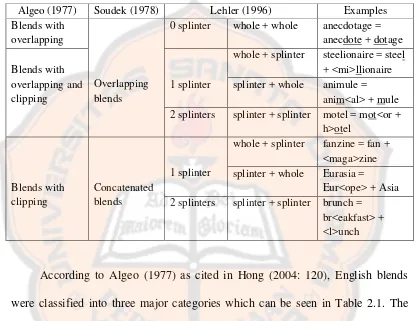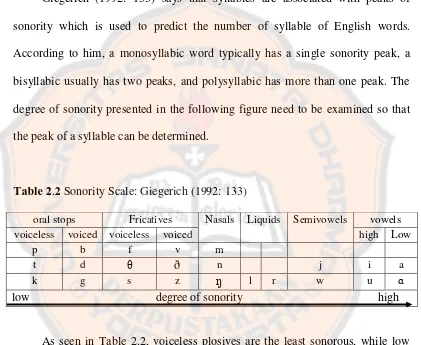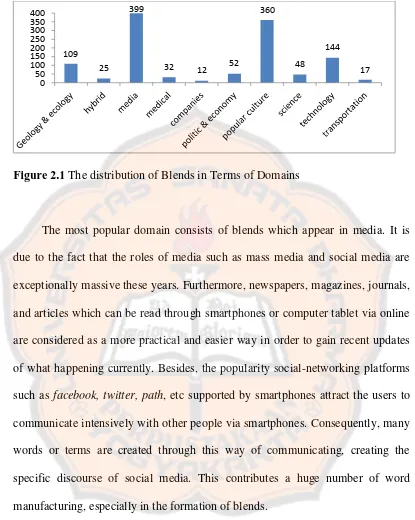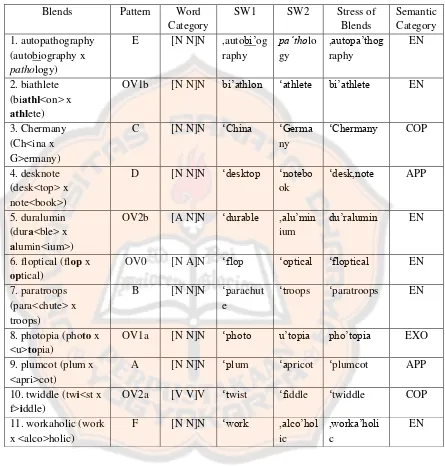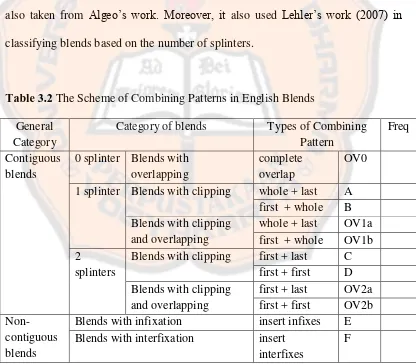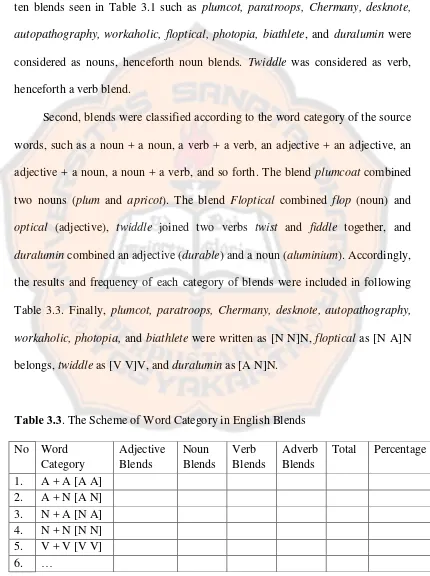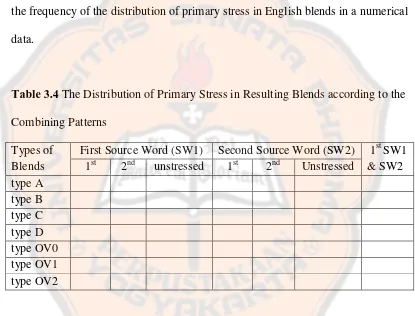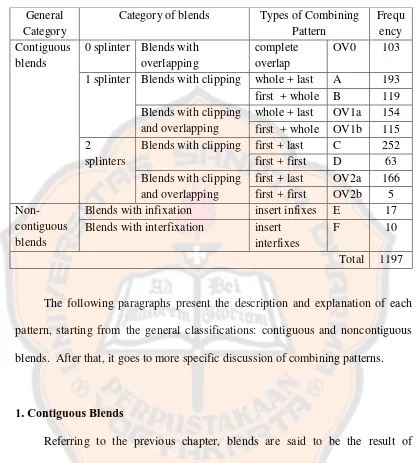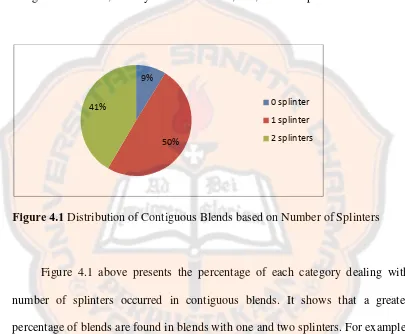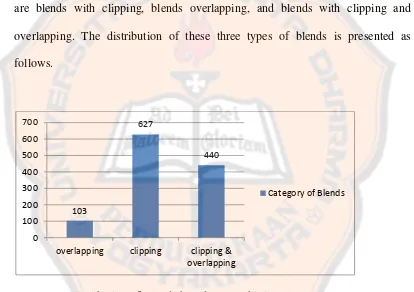xvii
ABSTRACT
Putranti, Adria Indah. 2015. Blends in Current English. Yogyakarta: The Graduate Program in English Language Studies, Sanata Dharma University.
This is a linguistic study which focuses on the morphology and prosodic morphology of English blends. More specifically, it attempts to uncover the combining patterns and characteristics of stress assignment in English blends. It used 1197 English blends which were collected from seven online dictionaries and websites, namely Oxford, Merriam-Webster, Collins Dictionary, Cambridge, Word Spy, Rice University Neologisms Database, and Urban Dictionary.
Henceforth, this study is aimed at answering four research questions: (1) What blending patterns are observed in English blends? (2) What word categories are English blends derived from? (3) What phonological characteristics of the elements are retained in English blends? (4) What patterns of meaning are observed in English blends?
In answering these four research problems, the researcher used various analyses. The morphological analyses were employed to answer the first and second research questions. The analysis of prosodic morphology was conducted to answer the third research question. Meanwhile, the semantic analysis was used to answer the fourth research question.
The analyses yield four findings. The first finding is that blending in English does not only combine contiguous parts, but also noncontiguous parts. There are seven combining patterns which are classified as contiguous blends, namely clipping blends type A (whole + last part), clipping blends type B (first part + whole), clipping blends type C (first part + last part), clipping blends type D (first part + first part), overlapping blends type OV0 (zero splinter), overlapping blends type OV1 (one splinter), and overlapping blends type OV2 (two splinters). In terms of noncontiguous blends, there are two patterns which can be observed, namely blends type E (blends with infixation) and blends type F (blends with interfixation).
The second finding shows that there are ten pairs of word category in blends. Chiefly, blends can be formed from two adjectives, two nouns, two verbs, two adverbs, an adjective and a noun, a noun and an adjective, a noun and a verb, a verb and a noun, an adverb and an adjective, and a pronoun and a noun. These ten pairs are classified into four major categories, namely noun blends, adjective blends, verb blends, and adverb blends.
xviii
(syllable size) and more specifically have the same number of X-positions in rhyme (syllable weight).
xix
ABSTRAK
Putranti, Adria Indah. 2015. Blends in Current English. Yogyakarta: Program Pasca Sarjana Kajian Bahasa Inggris, Universitas Sanata Dharma.
Penelitian ini merupakan studi linguistik yang berfokus pada studi morfologi dan prosodik morfologi. Khususnya, penelitian ini mencoba untuk mengungkap pola penggabungan dan ciri penekanan kata pada proses paduan kata/ amalgam. Penelitian ini menggunakan 1197 data yang diambil dari tujuh situs dan kamus online, yaitu Oxford, Merriam-Webster, Collins Dictionary, Cambridge, Word Spy, Rice University Neologisme Database, dan Urban Dictionary. Selanjutnya, tujuan dari penelitian ini adalah untuk menjawab empat pertanyaan penelitian: (1) Apa saja pola penggabungan dalam proses paduan kata/ amalgam dalam bahasa Inggris? (2) Apa jenis kata yang membentuk paduan kata/ amalgam? (3) Apa saja karakteristik fonologi dari unsur-unsur yang dipertahankan dalam paduan kata/ amalgam? (4) Apa saja pola makna yang terkandung dalam paduan kata/ amalgam?
Untuk menjawab keempat pertanyaan tersebut, peneliti menggunakan berbagai analisa. Analisa morfologi digunakan untuk menjawab pertanyaan pertama dan kedua. Analisa morfophonologi digunakan untuk menjawab pertanyaan ketiga. Sementara itu, analisa semantic digunakan untuk menjawab pertanyaan keempat.
Analisa-analisa tersebut menghasilkan empat temuan. Temuan pertama yaitu bahwa proses paduan kata tidak hanya menggabungkan bagian kata yang bersentuhan saja, melainkan juga menggabungkan bagian kata yang tidak bersentuhan. Terdapat tujuh pola paduan kata yang termasuk dalam bagian kata yang bersentuhan, yaitu clipping blendstipe A (seluruh + bagian akhir), clipping blends tipe B (bagian awal + seluruh), clipping blends tipe C (bagian awal + bagian akhir), clipping blends tipe D (bagian awal + bagian awal), overlapping blends tipe OV0 (nol pecahan),overlapping blends tipe OV1 (satu pecahan), dan
overlapping blends tipe OV2 (dua pecahan). Dalam hal bagian kata yang tidak bersentuhan, terdapat dua pola yang dapat diamati, yaitu paduan kata tipe E (paduan kata dengan infixation) dan paduan kata tipe F (paduan kata dengan
interfixation).
Temuan kedua yaitu terdapat sepuluh pasang jenis kata dalam paduan kata. Utamanya, paduan kata terbentuk dari dua kata sifat, dua kata benda, dua kata keterangan, kata sifat dengan kata benda, kata benda dengan kata sifat, kata benda dengan kata kerja, kata kerja dengan kata benda, kata keterangan dengan kata sifat, kata benda dengan kata kerja, kata kerja dengan kata benda, kata keterangan dengan kata sifat, dan kata ganti dengan kata benda. Kesepuluh pasang tersebut dapat digolongkan ke dalam empat kategori utama, yaitu paduan kata dari kata benda, kata sifat, kata kerja, dan kata keterangan.
xx
stress dalam paduan kata tidak serta merta ditentukan oleh stress dari salah satu atau kedua sumber. Sebaliknya, stress ditentukan kembali dari awal, mengikuti aturan pembentukan kata baru. Dalam hal paduan kata yang tidak bersentuhan,
ciri stress dalam paduan dengan infixation adalah bahwa stress cenderung
mengikuti stress dari kata dasar selama elemen yang ditukarkan (segmen yang dihapus dengan infiks) memiliki jumlah yang suku kata dan jumlah X (rima) yang sama.
i
BLENDS IN CURRENT ENGLISH
TITLE PAGE
A THESIS
Presented as a Partial Fulfillment of the Requirements to Obtain the Magister Humaniora (M.Hum.) Degree
in English Language Studies
by
Adria Indah Putranti Student Number: 136332048
THE GRADUATE PROGRAM IN ENGLISH LANGUAGE STUDIES SANATA DHARMA UNIVERSITY
vi
DEDICATION
vii
ACKNOWLEDGEMENTS
It was a long journey for me to finish this thesis. I faced many difficulties during the writing of this thesis. Nevertheless, a lot of help and support from people around me really made me strong. In this moment, I would like to appreciate those who have been involved in the process of finishing my thesis.
I would express my deepest gratitude toDr. Fr. B. Alip, M.Pd., M.A.,my advisor, for every advice, support, and guidance. He is surely the first person to whom my gratitude is expressed. He is the one who has always been enthusiastic in giving insights during consultation, commenting on many things, and making jokes in every moment. I always took a note for every single word he uttered since I always thought that all of his saying was important. The way he remembered names of every student in his GRP class had surely made us enthusiastic to be part of his class. Furthermore, he always asked me to finish my thesis as soon as possible.
My special gratitude goes toDr. B. B. Dwijatmoko, M.A., who was very helpful in overcoming the difficulties emerged during my study in ELS. He was the one who helped me to get the idea for this thesis topic so that I could develop my topic then.
I would also like to extent my gratefulness to all lecturers of Sanata Dharma University, especially the Graduate Program in English Language Studies:
Prof. Dr. Soepomo Poedjosoedarmo, F. X. Mukarto, Ph.D., Dr. J. Bismoko, Paulus Sarwoto, S.S., M.A., Ph.D., Dr. J. Haryatmoko, S.J., Mutiara Andalas, S.J., S.S., S.TD., Drs. Barli Bram, M.Ed., Ph. D., and Dr. Alb. Budi Susanto, S.J., for every guidance and staff of ELS, USD who helped me doing things related to the administration during this study.
viii
need help and support. I should not forget to appreciate my mother and father in law, who have always supported and become “reminder” for me to finish my study as soon as possible.
I should thank my classmates, especially Joan and Mas Ryan for every support, courage, and wonderful time we spent when we were in linguistics class. Very special thanks and loves are dedicated to all ELS students of 2013 class,
Anin, Bu Sitta, Mbak Tuti, Bundo Wulan, Ce Vivi, Levyn, Aik, Dewi, Mbak Yunita, Mbak Dian, Mbak Dina, Gaby, Mbak Nurul, Desta, Mas Bayu, Bu Asti, Rieta, Tia, Nita, Inta, Pak Tangguh, Putri, Mbak Mimi, Mbak Rina, Dita, and Siwi. Thanks for being there for me both in ups and downs, and thanks for every kindness, love, care, and friendship.
I would like to give my thanks to all other supporters whom I could not mention one by one. It is an honor of having accomplished my study in USD, but I would not achieve it without you all.
ix
TABLE OF CONTENTS
TITLE PAGE……… i
APPROVAL PAGE……….. ii
DEFENCE APPROVAL PAGE……….. iii
STATEMENT OF ORIGINALITY……… iv
LEMBAR PERNYATAAN PERSETUJUAN……….. v
DEDICATION……….. vi
ACKNOWLEDGEMENTS………. vii
TABLE OF CONTENTS………. ix
LIST OF TABLES……… xiii
LIST OF FIGURES………..……… xiv
LIST OF APPENDICES……….. xv
LIST OF TERMINOLOGIES……… xvi
ABSTRACT……….. xvii
ABSTRAK……….. xix
CHAPTER I. INTRODUCTION A. Background of the Study ………... 1
B. Problem Formulation ………. 6
C. Goalsof the Study ………..…………... 7
D. Definitions of Terms ……….. 8
E. Benefits of the Study……….. 10
CHAPTER II. LITERATURE REVIEW A. Theoretical Review ……….... 11
1. Previous Research on English Blends ………... 11
a. Hong’s Study on Properties of English Word-blends ………... 14
b. Lappe and Plag’s Study on the Role of Prosodic Structure in the Formation of English Blends ………... 17
x
a. Word-formation Process ………... 18
b. Combining Patterns of Blends ……….. 20
c. Syllabification Theory ………... 22
1)Syllable and Syllable Structure ……….………... 23
2)Syllabification Principle ……….…………. 24
a)Sonority Sequence Principle (SSP) ……….……… 24
b) Maximal Onset Principle (MOP)……….... 26
d. Prosodic Analysis in English Blends ……… 26
1)Definition of Stress ……….. 27
2)Degree of Stress ………... 28
3) Stress and Non-phonological Structure ……….. 29
4) Stress Placement……….. 30
e.Word Category ……….. 31
f. Meaning Identification in English Blends ………. 33
g. The Timeline of English Blends………... 34
h. The Distribution of Blends in Terms of Domains ……… 35
B.Theoretical Framework ……….. 46
CHAPTER III. METHODOLOGY A. Data of the Study and Data Source ……… 51
B. Approaches of the Study ……… 53
C. Method of the Study ……….. 54
1. Data Collection……….. 54
2. Data Analysis ………. 56
CHAPTER IV. DATA ANALYSIS A. Combining Patterns of Blends ………... 67
1. Contiguous Blends ………... 69
a. Blends with OneSplinter ………... 74
b. Blends with Two Splinters ……… 77
2. Noncontiguous Blends ………... 79
xi
b. Blends with Interfixation……….. 83
B. Word Categories of Source Words in English Blends ………... 85
1. Noun Blends……….. 88
2. Adjective Blends……… 91
3. Verb Blends………... 93
4. Adverb Blends………... 95
C. Phonological Characteristics of the Elements Retained in English Blends 96 1. Contiguous Blends……… 98
a. The Correspondence of the Primary Stress in Resulting Blends…... 98
b. Five Patterns of Stress Assignment in the Resulting Blends……… 101
1) The Equivalence between the Primary Stress in the Resulting Blends and the Primary Stress in SW1……… 103 2) The Equivalence between the Primary Stress in the Resulting Blends and the Secondary Stress in SW1……… 104 3) The Equivalence between the Primary Stress in the Resulting Blends and the Unstressed Syllable in SW1……… 106 4) The Equivalence between the Primary Stress in the Resulting Blends and the Primary Stress in SW2………... 107 5) The Equivalence between the Primary Stress in the Resulting Blends and the Primary Stress in SW1 and SW2……….. 108 c. The Characteristics of Stress Assignment in the Resulting Blends .. 110
1) The Correspondence of Primary Stress in Resulting Blends and Primary stress in One or Both Source Words………. 110
2) The importance of the Position of SW2………. 111
3) The Stress Assignment of Blends ……… 113
2. Noncontiguous Blends………. 115
D. Meaning Identification ofEnglish Blends ………... 119
CHAPTER V. CONCLUSION AND RECOMMENDATIONS A. Conclusion ………. 126
xii
BIBLIOGRAPHY……… 132
APPENDICES
APPENDIX 1……… 135
xiii
Combining Patterns of Blends: Hong (2004: 122)…………. Sonority Scale: Giegerich (1992: 133)………... The Scheme of Morphological, Morphophonological, and Semantic Analysis of English Blends………. The Scheme of Combining Patterns in English Blends……. The Scheme of Word Category in English Blends…………. The Distribution of Primary Stress in Resulting Blends according to the Combining Patterns……….. Distribution of Blends based on Combining Patterns………
Blends with Infixation……….
Blends with Interfixation………
Pairs of Word Category in English Blends……….
Examples of Noun Blends………..
Examples of Adjective Blends………
Examples of Verb Blends………...
Adverb Blends………
The Distribution of Primary Stress in Resulting Blends according to the Combining Patterns……….. Phonological Properties of Blends with Infixation…………
xiv
LIST OF FIGURES
Figure 2.1 Figure 4.1 Figure 4.2 Figure 4.3 Figure 4.4 Figure 4.5 Figure 4.6 Figure 4.7 Figure 4.8 Figure 4.9 Figure 4.10 Figure 4.11
The distribution of Blends in Terms of Domains………… Distribution of Contiguous Blends based on Number of
Splinters………
Distribution of Blends based on Combining Patterns……. Distribution of Blends with One Splinter………. Distribution of Blends with Two Splinters……….. The distribution of Word Category of Resulting Blends…. Word Category of Noun Blends………... Word Category of Adjective Blends……… Word Category of Verb Blends……… the Equivalence of the Primary Stress in Resulting Blends Five Patterns of Stress Assignment of Resulting Blends… The distribution of Blends based on the Semantic Types ..
xv
LIST OF APPENDICES
Appendix 1. Appendix 2.
List of Blends in Current English... The Distribution of Blends in Online Dictionaries...
xvi
LIST OF TERMINOLOGIES
A : Adjective
N : Noun
V : Verb
Adv : Adverb
Pron : Pronoun SW1 : Source Word 1 SW2 : Source Word 2
A : Clipping blends (whole + last) B : Clipping blends (first + whole) C : Clipping blends (first + last) D : Clipping blends (first + first) E : Blends with infixation F : Blends with interfixation
OV0 : Overlapping Blends with zero splinter
OV1 : Clipping and overlapping blends with one splinter
OV1a : Clipping and overlapping blends with one splinter (whole + splinter) OV1b : Clipping and overlapping blends with one splinter (splinter + whole) OV2 : Clipping and overlapping blends with two splinters
OV2a : Clipping and overlapping blends with two splinters (first + last) OV2b : Clipping and overlapping blends with two splinters (first + first) EN : Endocentric blends
xvii
ABSTRACT
Putranti, Adria Indah. 2015. Blends in Current English. Yogyakarta: The Graduate Program in English Language Studies, Sanata Dharma University.
This is a linguistic study which focuses on the morphology and prosodic morphology of English blends. More specifically, it attempts to uncover the combining patterns and characteristics of stress assignment in English blends. It used 1197 English blends which were collected from seven online dictionaries and websites, namely Oxford, Merriam-Webster, Collins Dictionary, Cambridge, Word Spy, Rice University Neologisms Database, and Urban Dictionary.
Henceforth, this study is aimed at answering four research questions: (1) What blending patterns are observed in English blends? (2) What word categories are English blends derived from? (3) What phonological characteristics of the elements are retained in English blends? (4) What patterns of meaning are observed in English blends?
In answering these four research problems, the researcher used various analyses. The morphological analyses were employed to answer the first and second research questions. The analysis of prosodic morphology was conducted to answer the third research question. Meanwhile, the semantic analysis was used to answer the fourth research question.
The analyses yield four findings. The first finding is that blending in English does not only combine contiguous parts, but also noncontiguous parts. There are seven combining patterns which are classified as contiguous blends, namely clipping blends type A (whole + last part), clipping blends type B (first part + whole), clipping blends type C (first part + last part), clipping blends type D (first part + first part), overlapping blends type OV0 (zero splinter), overlapping blends type OV1 (one splinter), and overlapping blends type OV2 (two splinters). In terms of noncontiguous blends, there are two patterns which can be observed, namely blends type E (blends with infixation) and blends type F (blends with interfixation).
The second finding shows that there are ten pairs of word category in blends. Chiefly, blends can be formed from two adjectives, two nouns, two verbs, two adverbs, an adjective and a noun, a noun and an adjective, a noun and a verb, a verb and a noun, an adverb and an adjective, and a pronoun and a noun. These ten pairs are classified into four major categories, namely noun blends, adjective blends, verb blends, and adverb blends.
xviii
(syllable size) and more specifically have the same number of X-positions in rhyme (syllable weight).
xix
ABSTRAK
Putranti, Adria Indah. 2015. Blends in Current English. Yogyakarta: Program Pasca Sarjana Kajian Bahasa Inggris, Universitas Sanata Dharma.
Penelitian ini merupakan studi linguistik yang berfokus pada studi morfologi dan prosodik morfologi. Khususnya, penelitian ini mencoba untuk mengungkap pola penggabungan dan ciri penekanan kata pada proses paduan kata/ amalgam. Penelitian ini menggunakan 1197 data yang diambil dari tujuh situs dan kamus online, yaitu Oxford, Merriam-Webster, Collins Dictionary, Cambridge, Word Spy, Rice University Neologisme Database, dan Urban Dictionary. Selanjutnya, tujuan dari penelitian ini adalah untuk menjawab empat pertanyaan penelitian: (1) Apa saja pola penggabungan dalam proses paduan kata/ amalgam dalam bahasa Inggris? (2) Apa jenis kata yang membentuk paduan kata/ amalgam? (3) Apa saja karakteristik fonologi dari unsur-unsur yang dipertahankan dalam paduan kata/ amalgam? (4) Apa saja pola makna yang terkandung dalam paduan kata/ amalgam?
Untuk menjawab keempat pertanyaan tersebut, peneliti menggunakan berbagai analisa. Analisa morfologi digunakan untuk menjawab pertanyaan pertama dan kedua. Analisa morfophonologi digunakan untuk menjawab pertanyaan ketiga. Sementara itu, analisa semantic digunakan untuk menjawab pertanyaan keempat.
Analisa-analisa tersebut menghasilkan empat temuan. Temuan pertama yaitu bahwa proses paduan kata tidak hanya menggabungkan bagian kata yang bersentuhan saja, melainkan juga menggabungkan bagian kata yang tidak bersentuhan. Terdapat tujuh pola paduan kata yang termasuk dalam bagian kata yang bersentuhan, yaitu clipping blendstipe A (seluruh + bagian akhir), clipping blends tipe B (bagian awal + seluruh), clipping blends tipe C (bagian awal + bagian akhir), clipping blends tipe D (bagian awal + bagian awal), overlapping blends tipe OV0 (nol pecahan),overlapping blends tipe OV1 (satu pecahan), dan
overlapping blends tipe OV2 (dua pecahan). Dalam hal bagian kata yang tidak bersentuhan, terdapat dua pola yang dapat diamati, yaitu paduan kata tipe E (paduan kata dengan infixation) dan paduan kata tipe F (paduan kata dengan
interfixation).
Temuan kedua yaitu terdapat sepuluh pasang jenis kata dalam paduan kata. Utamanya, paduan kata terbentuk dari dua kata sifat, dua kata benda, dua kata keterangan, kata sifat dengan kata benda, kata benda dengan kata sifat, kata benda dengan kata kerja, kata kerja dengan kata benda, kata keterangan dengan kata sifat, kata benda dengan kata kerja, kata kerja dengan kata benda, kata keterangan dengan kata sifat, dan kata ganti dengan kata benda. Kesepuluh pasang tersebut dapat digolongkan ke dalam empat kategori utama, yaitu paduan kata dari kata benda, kata sifat, kata kerja, dan kata keterangan.
xx
stress dalam paduan kata tidak serta merta ditentukan oleh stress dari salah satu atau kedua sumber. Sebaliknya, stress ditentukan kembali dari awal, mengikuti aturan pembentukan kata baru. Dalam hal paduan kata yang tidak bersentuhan,
ciri stress dalam paduan dengan infixation adalah bahwa stress cenderung
mengikuti stress dari kata dasar selama elemen yang ditukarkan (segmen yang dihapus dengan infiks) memiliki jumlah yang suku kata dan jumlah X (rima) yang sama.
CHAPTER 1
INTRODUCTION
This chapter consists of five sections. The first section is the background of the study. The second section is the problem formulation. The third section is the goals of the study. The last two sections are definitions of terms and benefits of the study.
A. Background of the Study
Throughout the history, English language has created a great number of new words. Many new words which contribute to the English language development are created from word-formation process. One of word-formation techniques is by combining two or more existing words known as blending. In this process, two or more words are joined together to make them one word and at least one part of them are shortened. As a result, blending always produces a single newly created word.
In view of that, the number of blends which are created the English language is very extensive. There are thousands of blends in English language. These blends really exist in English language because a lot of people actually use them in everyday life discourse or in a specific discourse. In everyday life, blends can be found in various domains, namely technology, sports, marketing, and slangs. In technology, blends such as blog (web x log),codec (coder x decoder), emoticon (emote x icon), and modem (modulator x demodulator) are easily found. Blends dealing with sports such as parasailing (parachute x sailing), streetball
(street x basketball), and joggling (jogging x juggling) are also discovered. Besides, blends like infotainment (information x entertainment), edutainment (education x entertainment), and cineplex (cinema x complex) are likewise blends in marketing domain. Furthermore, blends also exist in slang words such as
chuge, yumtastic, and brogards. As shown in The Rice University Neologisms Database (http://neologisms.rice.edu), chuge (crazy x huge) is regarded as a slang word used to refer to something which has the qualities of being very large.
Yumtastic is a blend of yummy and fantastic. It is a slang term used to describe foods that are particularly delicious, created to add an extra level of expression to a compliment about food. Brogards is a slang word which combines bro (brother)
and regards. It is defined as regards between bros which is usually used at the end of a conversation or letter.
As the consequence of this great number of new words, English speakers sometimes do not even recognize them as blends. Many conventional blends such as alphabet, bit, caplet, and smog might get little attention because they have become part of everyday language. These words are regarded as “common” words for many people, meaning that people occasionally do not have any idea on the word-formation processes occurred towards those words. But actually, these words have undergone a word-formation process called blending. However, blends like bit (binary x digit), caplet (capsule x tablet), and smog (smoke x fog),
In the era of modern English, the process of blending has threefold significance. First, blending is needed particularly to introduce new concepts or invention. It is due to the fact that there are a lot of new inventions in the human life especially in technology. Consequently, if there emerge new concepts or inventions, names are required. For instance, words such as email, digicam, bit,
and pixel are created to name the new invention in the advent of technology. The new words in other domains such as in cross-breeding animals, films, companies, and websites are also introduced. Some examples which are taken from Urban Dictionary (http://www.urbandictionary.com) are geep, mockumentary, FedEx,
and Yahooligans. Geep is used to name an animal as the result of a hybrid of goat
and sheep. The word mockumentary (mock x documentary) is used to name the television show in the film domain. FedEx (Federal x Express) is an American global courier delivery services company and Yahooligans (Yahoo x hooligans)
refers a Yahoo website which is kid-friendly. Therefore, it is obvious that blends are used to name new products and companies. Second, blending is widely used for a practical reason. For instance, the name Brangelina is used to address both
Brad Pitt and Angelina Jolie and the name baseketball refers to both baseball and
curious about what actually limon is, so that they try to find out more about the product.
As stated previously, the process of blending is commonly derived from two words which made up into one. Thus, it can be compared to another similar word-formation process. Referring to the definition, blending is somewhat alike to compounding, especially in terms of combining multiple words. The base words of blending can be derived from compound words. There are two types of blends which resemble compounds as observed by Plag (2003: 122). The first type includes blends which are seen as shortened compounds. In compounds, the first element modifies the second one as in greenhouse and darkroom. Similar to compounds, the first element of blends modifies the second element as in motel (motor x hotel). So, motel is a kind of hotel, not a kind of motor. After having the process of deletion in some parts, motel can be recognized as a shortened compound. The second type contains blends which resemble copulative compounds, such as in actor-director and writer-journalist. In copulative compounds, both actor-director and writer-journalist share properties of both elements. The example of this type in blending is Chermany (Ch<ina x G>ermany). Both China and Germany are the base words which have the similar semantic relation as in copulative compounds.
treated as two. The second dissimilarity is that some phonological materials in blends are deleted, while compounds are not.
However, the study of blending is not only limited to the area of morphology but also the area of phonology. The simple reason is that blends do not merely combine two or more elements as in word-formation process. Rather, it has to be adjusted for the sake of pronunciation. Moreover, if the elements of blends are separated, it is not only part or element of words but also the syllable and stress assignment are examined. It is obvious that blending also deals with syllable constituents (such as onset, nucleus, coda, or rhyme) and also stress assignment which are known as prosodic properties (Plag, 2003: 124). Therefore, it is needed to treat blending as a prosodic morphology which discusses the interaction between morphology (word-formation process) and phonology (prosodic properties).
This research used internet as the main source of data since new words could be easily obtained via internet. Moreover, this research needed up-to-date data dealing with blends. Therefore, the data were collected from seven online dictionaries and websites such as Oxford, Merriam-Webster, Collins Dictionary, Cambridge, Word Spy, Rice University Neologisms Database, and Urban
Dictionary. These online websites were always updated in publishing new words and reliable in providing a great deal of data.
blends, so it was called a study of prosodic morphology. These analyses were all crucial in the formation of blends. Next, blends provided many variations of the structure which was interesting to investigate further, such as variation of clipping and overlapping, variation of syllable constituents and stress assignment in blends. This led to the deeper investigation to find out the nature of its variations. Another reason was that according to many researchers, blending was considered as unproductive word-formation process compared to other word-formation process such as compounding and affixation. Therefore, the researcher was willing to put much attention to this kind of word-formation process.
Finally, this research attempts to uncover structures and patterns of blends in both morphological and phonological analysis. Therefore, the target of prosodic morphology of English blends in this study is to investigate the interaction of morphological structure and prosodic properties which are crucial for the formation of English blends.
B.Problem Formulation
In order to limit the discussion of English blending, four research problems have been formulated as follows.
1. What blending patterns are observed in English blends? 2. What word categories are English blends derived from?
3. What phonological characteristics of the elements are retained in English blends?
C.Goals of the Study
The objective of this research is to answer four research problems formulated in the problem formulation. Therefore, there are four goals which are going to achieve in this research. The first goal is to describe the combining patterns of English blends. This study uses the general combining patterns proposed by Algeo (1977) as observed by Hong (2004: 122) and combining patterns based on splinters which are proposed by Lehrer (2007). These combining patterns identify the combination of source words‟ elements which are
retained to make a blend. Accordingly, there are two objectives to achieve the first goal. The first objective is to identify which part of the source words that is combined to another word. The part of source words can be first part, final part, or the whole part. The second objective is to classify them based on combining patterns of English blends.
The second goal is to identify the word category of each source word in the English blends. Two objectives are presented to accomplish the second goal. First objective is to classify blends according to the word category of the source words, such as a noun + a noun, a verb + a verb, an adjective + an adjective, an adjective + a noun, a noun + a verb, and so forth. The second objective is to identify the nature of each category.
examine patterns of stress placement in English blends. The second objective is to identify the characteristics of stress placement of elements retained in the blends.
The fourth goal is to identify patterns of meaning in blends. The classification of meaning patterns are based on the logical relation between two or more source words with the resulting blends. The objectives of this third goal are to classify English blends based on the meaning relation and to identify the nature of each classification.
To sum up, by finding the results, it is expected to treat a blend as a complex linguistic unit which has a composite linguistic aspects, such as morphology, phonology, and semantic. As a final point, this study is going to provide comprehensible set of blends as well as describe them as what they are.
D.Definition of Terms
These following terms are some terms used in this research. Each term is presented along with its definition in order to maintain the focus of this research.
The term current English is defined in order to determine the range of time dealing with data collection. The word current denotes “happening now; of the
present time” (Oxford Advanced Learner’s Dictionary 8th
edition). Thus current English refers to English words which are used now in the present time.
Word category refers to linguistic category of words or classes of word. Radford et al. (2009: 129) classifies five major types of word classes, namely nouns (N), verbs (V), adjectives (A), adverbs (Adv), and prepositions (P). According to them, a noun is typically an abstract and concrete entity in the world. A verb denotes to any action, activity, or state of being. An adjective is a property which a noun possesses. An adverb typically modifies a verb, adjective, and another adverb indicating how, when, or why something happened or the degree to which a property characterizes an individual or event. Meanwhile, a preposition relates objects, people, and events.
Phonological characteristics in this research refer to the characteristics of any phonological properties the blended elements have when they are combined with other blended elements. It includes the discussion of prosodic properties such as syllable structure and stress assignment. The syllable structure deals with syllable constituents (onset, nucleus, coda, and rhyme) and syllable size (the number of syllable of the source words and resulting blends). The stress assignment has to do with stress placement of source words and resulting blends.
E.Benefits of the Study
This research, theoretically, may give a contribution to English Language Studies concerning the development of blending theory, especially for those blends which occur in current English. In the advent of science and technology, there are more and more variations of blends which enter the English language. In view of that, the investigation of new blends‟ formations is needed. This research deals with the combination of morphology and phonology analysis (henceforth prosodic morphology) of English blends. Therefore, this research may contribute to the blending theory concerning types, structures, word categories, and prosodic properties of blends in current English.
Practically, this research will give contribution to English language teachers and students who learn English blending. For English language teachers, this research provides numerous examples of blends and discussion on how to analyze them. It would enrich their teaching repertoire in terms of assisting students in understanding the concept of blending. For English language students, this research provides the basic knowledge of English blends. By providing more description of blends, types of blends, and how to separate blends, this research helps English language students to explore the base words and find more examples of blends.
CHAPTER II
LITERATURE REVIEW
This chapter presents two sections, namely theoretical review and theoretical framework. The theoretical review provides all theories which are relevant to answer the research questions. The theoretical framework provides relation among theories which are used to analyze the data.
A.Theoretical Review
The theoretical review consists of two main parts. The first part presents some previous studies conducted by different scholars in relation with the topic and the second part presents theories related to blending. These theories include word-formation process, combining patterns of English blends, syllabification theory, prosodic analysis in English blends, word category, and meaning identification in blending.
1. Previous Research on English Blends
According to some scholars, blending had been considered as a less productive word-formation process compared to other word formation processes such as compounding and affixation. Dealing with this notion, Bat-El (1996: 283) mentioned that blending was a “minor word formation process” especially in dealing with its productivity and popularity. She proposed that compounding and affixation were more popular than blending. Some morphology textbooks tended to give big portion to these processes to discuss, ignoring blending. Moreover,
Algeo (1977) as cited in Lee (2014: 1301) stated that blends were usually used in informal discourse as slang or as words which appear only once in certain discourse, so that people did not pay much attention for being listed in dictionary. In addition, some scholars also regarded blending as an unpredictable and uninteresting word-formation process. Bauer (1988: 39) as cited in Bat-El (1996: 283) said “in most cases…the new word is created from parts of two other words, with no apparent principles guiding the way in which the two original words are mutilated”. Referring to that statement, it was obvious that Bauer expressed his attitude that blending was irregular word-formation process. Lappe & Plag (2012: 3) who had collected previous research on blending stated that many scholars also treated blending as irregular word-formation process. Some other scholars who treated blending as an unpredictable word-formation process according to Lappe & Plag (2012: 3) were Marchand (1969) and Cannon (1986). Nevertheless, Lappe & Plag (2012: 3) also mentioned that there were some researchers which treated blending as a regular word-formation process, namely Kubozono (1990), Bat-El (2006), Bat-El & Cohen (2012), Bauer (2012), and Gries (2004; 2012).
Bat-El (2006) proposed that the length of blend was identical to the length of second source word, while Bauer (2012) gave the idea that the length of blends might not be longer than the second source words (Lappe & Plag, 2012: 6). Kubozono (1990) claimed that the length of blends was likely to be minimally as long as the length of second source words and his claim was supported by Gries (2004) who presented the similar idea (cited in Lappe & Plag, 2012: 7). Meanwhile, Cannon (1986) as cited in Lappe & Plag (2012: 7) stated that the length of blend was equivalent to the length of the longer one of two source words.
In terms of stress, Lappe & Plag (2012: 7) had listed a number of researchers who had conducted research in this area. Cannon (1986, cited in Lappe & Plag 2012: 7) proposed that the stress of the longer source word determined the main stress of the resulting blend. Bat-El (1996), Fischer (1998), and Bauer (2012) as cited in Lappe & Plag (2012: 7) stated that stress of resulting blends was equivalent to stress of second source words. According to Lappe & Plag (2012: 7), the similar result occured to Spanish blends which were examined by Pineros (2004), which showed that blends in Spanish resembled the prosodic structure of second source words. Gries (2004) supported these claims by mentioning that the stress of blends tended to be equivalent to the stress of the second source word (Lappe & Plag, 2012: 7).
in the formation of English blends. More explanations on how these studies were conducted will be presented on the following sections.
a. Hong’s Study on Properties of English Word-blends
This study was conducted by Sung-Hoon Hong (2004). Hong used 445 data collected from portal websites such as www.google.com and www.yahoo.com and also a dictionary of portal website such as www.onelook.com. This study attempted to provide the description of the important structural properties of English blends. Chiefly, Hong‟s study involved both morphological and phonological analysis. In the morphological analysis, Hong categorized blends according to the pattern of combination when two source words joined together. In the phonological analysis, Hong examined the prosodic structures of blends such as length and stress.
There were two important points obtained in the study which were essential in the formation of English blends. The first point dealt with combining patterns of blends. According to Algeo (1977) as cited in Hong (2004: 119), blends were likely to be either „contiguous‟ and „noncontiguous‟. He mentioned that contiguous blends included contiguous segments which retained in blends, while noncontiguous blends consisted of implanted segments which might be put in the middle of another. He provided some examples of noncontiguous blends such as
askility (ability x skill) and destarture (departure x start).
order according to the year: Algeo‟s (1977), Soudek‟s (1978), and Lehler‟s (1998). These three combining patterns are presented in following Table 2.1.
Table 2.1 Combining Patterns of Blends: Hong (2004: 122)
Algeo (1977) Soudek (1978) Lehler (1996) Examples Blends with
whole + splinter steelionaire = steel + <mi>llionaire splinter + whole animule =
anim<al> + mule 2 splinters splinter + splinter motel = mot<or +
h>otel 2 splinters splinter + splinter brunch =
br<eakfast> + <l>unch
second source word (anecdotage = anecdote + dotage). The third category of blends proposed by Algeo (1977) as cited in Hong (2004: 121) involved blends with clipping and overlapping. This category was classified into three types. The first type occured when there was overlapping and clipping of the last part of first source word (animule = anim<al> + mule). The second type was overlapping and clipping of the first part of second source word (steelionaire = steel + <mi>llionaire). The third type was overlapping and clipping of the last part of first source word and the first part of second source word (motel = mot<or x h>otel).
As shown in Table 2.1, the combining patterns proposed by three researchers corresponded to one another (Hong, 2004: 121). By using Soudek terms, concatenated blends were the same as blends with clipping proposed by Algeo. Both concatenated blends and blends with clipping only included clipping and therefore exclude overlapping. Overlapping blends as mentioned by Soudek were in correspondence with blends with clipping and overlapping and blends with overlapping proposed by Algeo. Furthermore, each type of blends presented by Algeo and Soudek could be examined more deeply by observing the splinters mentions by Lehrer.
b. Lappe and Plag’s Study on the Role of Prosodic Structure in the
Formation of English Blends
This study was conducted by Sabine Aerndt-Lappe and Ingo Plag (2012). This study was more specific than Hong‟s study since it focused on the prosodic structures of English blends. It investigated more on the role of stress in determining the switchpoint of the two source words in blends and on the investigation of what determined the stress pattern of blends.
Different with Hong‟s study which collected the data from websites, the data of their study study were obtained by conducting an experimental study. This study required the researchers to collect the data by distributing a questionnaire. The respondents were 29 native speakers of Irish English and they were asked to coin 60 pairs of source words. The results showed that the length of the blend, the location of the switchpoint, and the stress of the blend were significantly determined by stress properties of the two source words of the blend especially by those of the second word.
2. Review of Related Theories
This section reviews six theories related to the study of English blending. These theories are word-formation process, combining patterns of English blends, syllabification theory, prosodic analysis in English blends, word category, and meaning identification in blending.
a. Word-formation Process
Word-formation process is one of the morphological rules applied in the composition of word. Generally, there are two kinds of morphological rules characterized by the notion of lexemes, namely inflection rule and word formation rule (Plag, 2003: 17). The former targets the same lexemes, whereas the latter targets different lexemes. As the examples, the word balls and casts apply inflection rule, while football and independent apply word formation rule. When inflection rule is implemented in a word, the resulting word refers to the same lexeme. The insertion of affix –s in balls and casts does not make the words produce different lexemes. Rather, they remain as the same lexemes as the original words ball and cast. On the contrary, when the word formation rule is implemented in a word, the resulting word yields different lexemes. Football is a kind of sport, thus it produces different lexeme with the original words foot and
ball. The word independent also produces different lexeme with the root depend
and the base dependent. Finally, it is obvious that the inflection rule does not produce a new lexeme, yet the word formation rule does.
combining two existing words. The words butterfly, basketball, earthquake, moonlight, and lifetime are the examples of compounds. The second type produces a new lexeme with and without affixation. Therefore, it is then divided into two forms. The first form is derivation with affixation and the second form is derivation without affixation. Derivation with affixation is a type of word-formation process which affixes are inserted within a word. For instances, the affixes of dis-, -er, and –ee are inserted in the word dishonest, writer, and
employee. Therefore, this process involves prefixation, suffixation, and infixation. Derivation without affixation does not need affixes to produce a new lexeme. Rather, it depends on existing words. Accordingly, blending belongs to this category since it does not need affixes to derive a new lexeme. Some other types of derivation without affixation are conversion (such as in poor-the poor, empty-to empty, and water-to water) and truncation (such as in lab, demo, and condo).
which have the similar semantic relation as in copulative compounds. Thus, it can be inferred that brunch is both breakfast and lunch.
Despite the similarities, blends are different from compounding in some aspects. Lappe and Plag (2012: 2) present two differences in terms of prosodic properties such as syllable and stress. The first dissimilarity is that blends are syllabified and stressed like one phonological word, while compound words are treated as two. The second dissimilarity is that some phonological materials in blends are deleted, while compounds are not.
Blending and inflection are different in some aspects such as the notion of lexeme and its productivity (Plag, 2003: 14). In the notion of lexeme, blending belongs to derivation word formation process in which it produces new lexeme, whereas inflection does not. In terms of productivity, blending is less productive than inflection. Unlike blends, inflection is not limited to many restrictions. Most English words especially nouns and verbs can obtain inflection regarding to the choice of grammar (plural and tenses). For instance, the word house becomes
houses whenever it is in a plural form. The verb watch, watches, watched, watching are also used for the sake of grammar, depending on the the number of person and tenses.
b. Combining Patterns of Blends
Dealing with classifications of blend, the patterns of combining source words into blends are also taken into account. Algeo (1977) as cited in Hong (2004: 120) said that English blends were classified into three combining patterns, namely blends with clipping, blends with overlapping, and blends with clipping and overlapping. The first combining pattern consisted of blends with clipping. Blends with clipping occured when one part or more was deleted. Enarsson (2006: 5) mentioned four types which fitted into this pattern. The first type was when the whole part of the first word joined together with the last part of the second word. The examples were foodoholic (food + alcoholic) and fanzine (fan + magazine). The second type was when the first part of the first word combined with the whole part of the second word. The blends Eurasia (Europe + Asia) were the examples of the second type. The third type was when the first part of the first word combined with the last part of the second word. The blend brunch (breakfast + lunch) became the example. The fourth type was when the first part of both elements was combined. The examples were agitprop (agitation + propaganda)
and aldehyde (alcohol + dehydrogenatum).
Blends with overlapping occured when there was an overlap in both of the source words. Examples provided by Enarsson (2006: 4) were cellebrity (cell + celebrity) and sinema (sin + cinema). It was obvious that there were elements of two source words which were similar so that it created an overlap in the blend. In
celebrity, the word cell completely overlapped with the first part of second word
In terms of blends with clipping and overlapping, Algeo (1977) as cited in Enarsson (2006: 6) presented some examples. They were Californication (California + fornication), suspose (suspect + suppose), and Hungarican (Hungarian + American). Examining these examples, it was obvious that blends with clipping and overlapping included both clipping and overlapping segments.
In addition, Lehrer (2007: 118) presented five patterns of English blends. Firstly, blends were created from a full word followed by a splinter. The instance was the blend steelionaire which was the combination of a full word steel and a splinter <mi>llionaire. Secondly, the pattern was the contrary of the first one. It was the combination of a splinter and a full word. The example of this pattern was
Eurasia. It combined a splinter Eur<ope> and a full word Asia. Thirdly, it could be formed from two splinters. The example was the blend agitprop. Agitprop was formed by combining two splinters agit<ation> and prop<aganda>. Fourthly, blends were structured from the complete overlap of one or more morpheme. In this pattern, there was no splinter combined. Rather, there was an overlap. The blend cellebrity obtained from cell and celebrity, for instance, there was an overlap part in cell. Lastly, the last pattern was the rare one. It was formed when the word or clipping was embedded in another word, thus it was treated as an infix. The example was chortle which combined chuckle and snort. In chortle, the part of word snort was embedded as an infix in the word chuckle.
c. Syllabification Theory
is divided into two parts (Bokhari and Pervez, 2003: 64). First part is Sonority Sequence Principle (SSP) and the second part is Maximal Onset Principle (MOP).
1). Syllable and Syllable Structure
Crystal (2008: 467) defines a syllable as a unit of pronunciation which is generally larger than a single sound, but smaller than a word. Thus, a syllable is a greater unit other than segment. A syllable can be said as having segments which form the phonological structure. Therefore, it is considered as a suprasegmental unit since it is composed of segments. Suprasegmental refers to those features which extend over more than one segment.
Basically, a syllable is a unit of speech that consists of a nucleus (usually vowels) surrounded by onsets (consonants) and codas (consonants). A word which contains a single syllable is called a monosyllabic word, while if it consists of more than one syllable, it is called a polysyllabic word (Giegerich, 1992: 138).
The number of segments is important in recognizing English syllables. The onset has a maximum consonant number of two. Three consonants are allowed as long as it includes a sequence of three-consonant cluster, namely /s/ as the first segment, voiceless stops (/p/ or /t/ or /k/) as the second segment, and approximants (liquids or glides) as the third segment. Coda has two consonants at maximum. The third segment allowed is /s/, /z/, /t/. Each segment in both onset and coda constitutes one X (Aitchison, 2003: 49).
Rhyme is essential in syllable since it determines whether the syllable is well-formed or not. The number of X is used as the basic of this consideration. A well-formed syllable consists of maximum 3-X positions in the Rhyme. Stressed vowel needs to have minimum 2-X position in Rhyme, thus it is called heavy syllable. Conversely, unstressed vowel must have minimum 1-X position in Rhyme so-called light syllable (Giegerich, 1992: 143-146).
2) Syllabification Principle
Most languages tend to follow these following two principles of syllabification, namely Sonority Sequence Principle (SSP) and Maximal Onset Principle (MOP). In fact, several languages do not follow MOP, but most of the languages follow SSP (Bokhari and Pervez, 2003: 64).
a) Sonority Sequence Principle (SSP)
syllable usually has a peak consisting of the most sonorous element within a syllable (vowels) which is recognized as nucleus. Onsets and codas are the second and third elements of the syllable. A nucleus becomes the core of the syllable so that its presence is obligatory. Conversely, codas and onsets are not obligatory.
Giegerich (1992: 133) says that syllables are associated with peaks of sonority which is used to predict the number of syllable of English words. According to him, a monosyllabic word typically has a single sonority peak, a bisyllabic usually has two peaks, and polysyllabic has more than one peak. The degree of sonority presented in the following figure need to be examined so that the peak of a syllable can be determined.
Table 2.2 Sonority Scale: Giegerich (1992: 133)
oral stops Fricatives Nasals Liquids Semivowels vowels voiceless voiced voiceless voiced high Low
p b f v m
t d θ ð n j i a k g s z ŋ l r w u
low degree of sonority high
The sonority scale is used to determine the number of syllables. Giegerich (1992: 133) provides two examples: clamp and Andrew. The word like clamp is considered as a monosyllable since it employs one sonority peak. The word
Andrew is considered as a bisyllable since it employs two sonorant segments.
b) Maximal Onset Principle (MOP)
Maximal onset principle is a rule which requires syllable boundaries to be placed in such a way that onsets are maximal (Giegerich, 1992: 170). This rule requires a consonant which may occupy either onset or coda) goes to onset position rather than coda position. For instance, if the word metron is separated by a syllable boundary, it becomes [me.trǝn] rather than [met.rǝn]
O‟Grady et al. (2005: 87) provide two words as examples, such as extreme
and decline. According to the maximal onset principle, they are syllabified as [ k.strɪm] and [dɪ.klajn]. Whereas the fact the incorrect syllabifications, such as [ k.strɪm] and [dɪ.klajn] do not violate any phonotactic constraints. It leads to the conclusion that syllabifications are prevented by a universal syllable-shape constrains that require the onset to be as large as possible.
d. Prosodic Analysis in English Blends
than a single segment forming a complex word (suprasegmental). For the sake of articulation of suprasegments, phonological features such as syllable length and stress assignment are joined together in the analysis so-called prosodic analysis.
Prosodic features are suprasegmental (Collins & Mees, 2003: 109). In this regard, they are not confined to any one segment, but they occur in some higher level of a word. Stress, which is the property of syllable, is one of the prosodic features. When a syllable is stressed, the emphasis and focus are given to that syllable. Furthermore, people can easily determine whether the word is a noun or a verb by focusing on where the syllable is stressed in a word. A prosodic feature which can be observed in blends is stress assignment of word, henceforth word stress.
1) Definition of Stress
Stress is considered as a suprasegmental feature which has more than single segment such as syllable. Thus, stress can be assigned as the property of syllable. Moreover, stress in English is phonemic. When different stress is assigned in a different syllable of a word, it conveys different meaning. The word record is said as having two lexical categories, namely a noun and a verb. If the stress is assigned in the initial syllable, it is considered as a noun. If the stress is on final syllable, it is considered as a verb.
strength of stress. If a syllable is articulated with higher pitch, it indicates that the syllable bears stronger stress. The third characteristic is vowel quality. Vowel quality is related to central or peripheral vowels which are essential in determining stress. Stressed syllable contains peripheral vowel such as /e/, whereas unstressed syllable contains central vowel such as /ǝ/. The fourth characteristic is duration of vowels. Duration of vowels is associated with the length. Stressed syllable is longer in duration than unstressed syllable.
2) Degree of Stress
Stress cannot be applied in an isolated syllable because the application of stress really depends on the degree of prominence among syllables in a word. As mentioned previously, the prominence of a syllable depends on the loudness, pitch, quality, and duration. English lexical word normally has one stressed syllable and the neighboring syllables are unstressed.
The differences between stressed and unstressed syllable are presented by Collins and Mees (2003: 111) using four characteristics of stress, namely intensity, pitch, quality, and duration. First, stressed syllable is articulated with greater breath and muscular effort so that it obtains greater loudness. On the contrary, unstressed syllable perceives less loudness. Second, stressed syllable experiences change in pitch, whereas unstressed syllable follow the pitch of previous stressed syllable. Third, Stressed syllable contains any vowel except /ǝ/
A longer English word typically bears more than one stressed syllable, namely primary and secondary stressed syllable. Primary stressed syllable is the strongest stressed syllable in a word in which it will be pronounced louder with higher pitch, and longer duration, whereas secondary stressed syllable is weaker. The other syllables are treated as unstressed syllables. Primary and secondary stress is recognized by using [„] mark for primary syllable and [,] mark for secondary syllable.
3) Stress and Non-phonological Structure
Giegerich (1992: 189) states that the rules of stress placement in English somehow rely on non-phonological information. Non-phonological information such as syntactic categories and morphological information provide regulation in assigning the stress placement in English.
Dealing with syntactic category, it provides information which syllable the stress of certain syntactic category is assigned to. According to Giegerich (1992: 190), verbs and adjectives commonly bear final stress, but it is rare for nouns to have that stress pattern. In addition, stress is only assigned in syntactic categories such as noun, verb, adjective, and adverb, whereas function words such as articles, prepositions, and pronouns do not bear any stress.
stress structure of their base. For instance, the insertion of the suffix –s in rulers
does not change the stress structure since the main stress remains on the initial syllable. Second, the suffixes are always unstressed (as in pennilessness). Derivational suffixes have the characteristics of stress-shifting in two aspects. First, the stress structure of the base is different from that of base word without a suffix. For instance, the word ‘atom (initial) and a’tomic (penultimate) are different in stress placement. Second, suffixes may bear the main stress of the resulting words. The suffixes –ee and –ese as in em,ploy’ee and ,Japa’nese bear the main stress. It is noted that the syllables of these stressed affixes are heavy.
4) Stress Placement
Giegerich (1992: 183) makes the classification of stress placement simpler by classifying them into final and non-final stress. In dealing with the stress assignment, syllable weight plays a significant role. Final stressed syllable is always heavy, just as there is no stressed final syllable which is light. In bisyllabic words which enable the words to have two stresses, both primary and secondary stressed syllables are heavy. The secondary stress may occur on the initial syllable only when the syllable is heavy. For instance, ,ho’tel and ,bam’boo have two stressed syllables in syllable initial (secondary) and final (primary). According to the syllables weight, both primary and secondary stress are heavy syllables. Besides, Giegerich (1992: 184) also notes that heavy initial syllables do not necessarily have secondary stress as shown in ob’scure (not ,ob’scure).
syllable, there assigns a final stress. If the bisyllabic words have heavy-heavy syllable, there is a stress pattern variant of secondary-primary and primary-secondary. Second, final stress in English normally occurs in verbs and adjectives. Final stress in Nouns is rare, yet it is usually found in loanwords. Third, final stress can be used to differentiate between noun and verb in English. Nouns normally have non-final stressed syllable, while verbs normally have final stressed syllable.
Non-final stress is common in English nouns. In non-final stress, the final syllable does not have stress. Since the last syllable does not bear any stress, the stress is assigned in the second and third syllable from the last. In word stress, the number of syllable is counted from the end of the word. The word to’mato has a stress in the second syllable from the last syllable so called penultimate syllable. The word „cinema has a stress in the third syllable from the end called
antepenultimate syllable.
The regularities of the non-final stress presented by Giegerich (1992: 187) are as follows. Stress is assigned on the penultimate syllable if the syllable is heavy. If the penultimate is light, stress is assigned on the antepenultimate syllable. If the penultimate syllable is light and the word does not have antepenultimate syllable, stress falls on the penultimate.
e. Word Category
The language users should know which ones are categorized as nouns, which ones are regarded as adjectives, verbs, adverbs, or prepositions.
Started by distinguishing between content words and function words, Finegan (2004: 185) suggests that content words “have meaning in that they refer to objects, events, and abstract concepts; are marked as being characteristic of particular social, ethnic, and regional dialects and of particular contexts; and convey information about the feelings and attitudes of language users.” Besides, Aronoff & Fudeman (2011, 42-43) mention the member of content words and the examples such as nouns (baby, bargain), adjectives (peaceful, bright), verbs (publicize, sleep), and adverbs (readily, carefully). Function words also have meaning, however it is in different ways from content words (Finegan, 2004: 185). Additionally, Aronoff & Fudeman (2011, 42-43) suggest that function words are defined based on their function. According to them, members of this category are pronouns (I, him, our), determiners (the, an, a), prepositions (in, by), demonstratives (this, those), verbs (am, was), and adverbs (very, not).
f. Meaning Identification in English Blends
The meaning of blends is identified according to the meaning relation between its two source words. Since blends are seen as shortened compounds (Plag, 2003: 122), the way on how to identify the meaning of blends is similar to compounds. In general, the meaning of compounds is divided into two major types, namely endocentric and exocentric meaning (Szymanek, 1989: 48-50). Similar to compounds, endocentric meaning in blends denotes the meaning construction in which the meaning is derived from the elements of blends. Thus, it is said that the meaning is inside blends. On the contrary, exocentric meaning is a meaning construction in which the meaning is outside blends.
